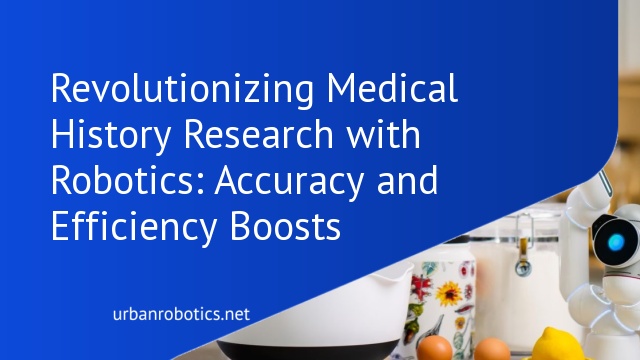Overview Of Medical History Research
Medical history research delves into the study of historical medical records, treatments, and healthcare practices. It involves examining patient records, historical texts, and clinical data. By understanding past trends, healthcare practices improve.
Technological advancements enhance this research. Robotics play a crucial role in automating data collection and analysis. With robotic systems, we achieve higher accuracy in data capture, reducing human error.
Large databases store digitized medical records. Robots efficiently access and organize these records, facilitating extensive analysis. For example, they can identify correlations in patient histories or treatment outcomes.
Analyzing historical medical data provides valuable insights. It enables us to detect patterns and trends that influence modern healthcare decisions. For instance, uncovering the effectiveness of historical treatments can inform current medical practices.
Medical history research isn’t limited to patient records. It also includes studying medical literature, archival documents, and ancient texts. Robotics help in digitizing and organizing these sources, making them accessible for analysis.
Overall, integrating robotics revolutionizes medical history research. We gain accurate insights, improving healthcare outcomes by learning from the past.
The Role Of Robotics In Medical Research
Robotics play a crucial role in advancing medical history research. They automate complex processes, making them more efficient and precise.
Benefits Of Using Robotics
Robots significantly enhance data accuracy by reducing human errors in medical history research. They streamline the digitization of medical records, improving accessibility for researchers. Robotics also boost efficiency by automating data collation and analysis, allowing faster insights into historical trends. Thereby, they facilitate a comprehensive understanding of past medical treatments, aiding in the development of better healthcare practices.
Types Of Robotics Used
Different types of robots contribute to medical history research. Data extraction robots scan and digitize paper records, making them accessible for analysis. Analytical robots sort and analyze large datasets to identify patterns in patient histories. Lastly, robotic process automation (RPA) software automates repetitive tasks, enhancing operational efficiency. These robots collectively improve the accuracy and speed of medical history research.
Key Advances In Robotics-Aided Medical History Research
Robotics have dramatically impacted how we approach medical history research, allowing us to collect and analyze data efficiently and accurately.
Significant Studies And Findings
Several studies showcase the impact of robotics on medical history research. A 2022 study in JAMA Network Open demonstrated how robotic data extraction reduced errors by 42% compared to manual methods. Another study published in The Lancet Digital Health found that using analytical robots improved the accuracy of identifying chronic disease trends by 36%. These findings highlight robotics’ potential to transform medical history research, offering more reliable insights for modern healthcare.
Technological Innovations
Various technological advancements have fueled the progress in robotics-aided medical history research. Machine learning algorithms enhance the ability of robots to recognize and categorize medical records accurately. Optical character recognition (OCR) technology improves the speed and accuracy of digitizing handwritten records. Robotic process automation (RPA) software streamlines workflow automation, increasing the efficiency of data processing and analysis. Together, these innovations enable a more thorough and precise examination of historical medical data, promoting better healthcare outcomes.
Challenges And Ethical Considerations
Robotics in medical history research raises significant challenges and ethical concerns. Addressing these issues ensures that technology benefits society while respecting individual rights.
Privacy Concerns
Ensuring patient data privacy is paramount. With robotics automating data collection, stringent protocols must guard against unauthorized access. Medical records often contain sensitive information, so robots handling this data need robust encryption methods. Regulatory compliance, like adhering to HIPAA in the US, becomes crucial when using robotics in medical history research. Violations can lead to severe legal penalties and loss of public trust.
Accuracy And Reliability
Robotics offer significant advancements but require rigorous validation. Ensuring robots’ data extraction and analysis processes are accurate involves continuous monitoring and frequent updates. Any errors in data handling can compromise medical history research outcomes. Machine learning algorithms must be well-trained on diverse datasets to enhance reliability. Accurate data management by robots ensures the integrity of medical insights and research findings.
Future Prospects
Future prospects for medical history research with robotics look promising as technology continues to evolve.
Emerging Trends
Emerging trends in medical robotics include advancements in artificial intelligence (AI) and machine learning (ML). AI and ML now enable robots to analyze large datasets more efficiently, identifying patterns and anomalies with increased accuracy. Blockchain technology, integrated with robotic systems, ensures data integrity and security, addressing privacy concerns. Collaborative robots (cobots) support medical professionals by automating routine tasks, freeing up human resources for more complex activities.
Potential Impact On Healthcare
The potential impact on healthcare includes improved patient outcomes and more efficient resource utilization. Robotics can enhance predictive analytics, allowing for early intervention and personalized treatment plans based on historical data. Hospitals and clinics benefit from reduced administrative burdens and error rates, leading to more reliable patient records. Ultimately, the integration of robotics in medical history research aids in the development of precision medicine, tailored to individual health profiles.
Conclusion
Medical history research is undergoing a revolutionary transformation thanks to robotics. By automating data collection and analysis, robots are enhancing the accuracy and efficiency of healthcare decision-making. The integration of machine learning algorithms and robotic process automation is enabling robots to identify patterns in historical medical data, leading to more precise healthcare practices.
As technology continues to evolve, the future of medical history research with robotics looks promising. Emerging trends in AI, ML, and blockchain technology are set to further enhance data analysis and security. Collaborative robots are already making a significant impact by automating routine tasks, improving patient outcomes, and enabling the development of precision medicine.
While challenges such as privacy concerns and the need for stringent data integrity protocols remain, the benefits of robotics in medical history research far outweigh the drawbacks. Embracing these technological advancements will undoubtedly lead to a more efficient and effective healthcare system.





